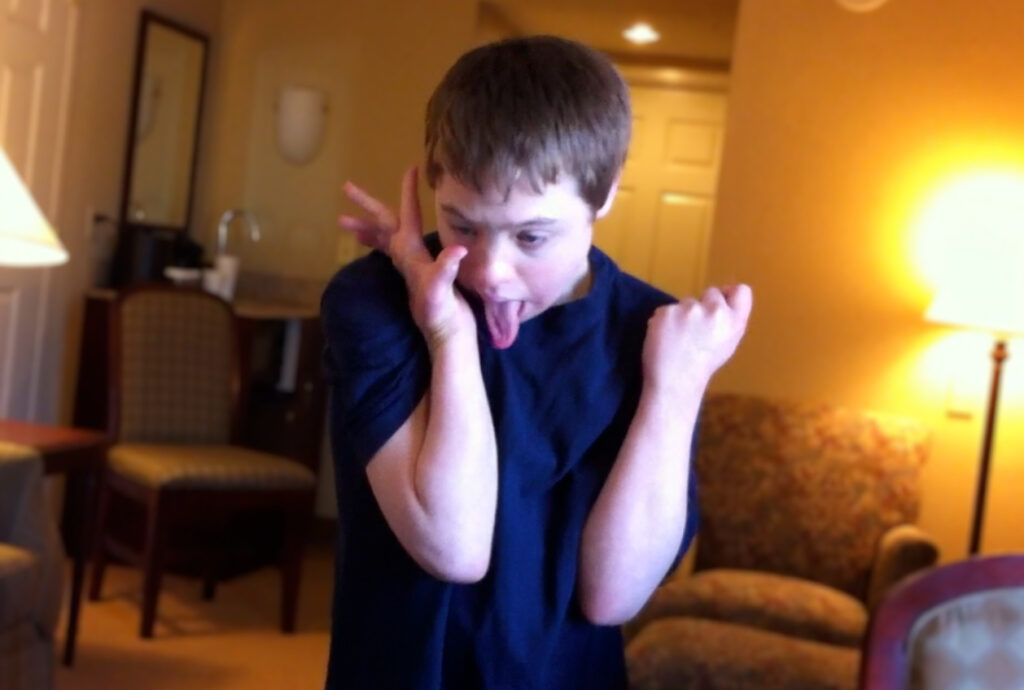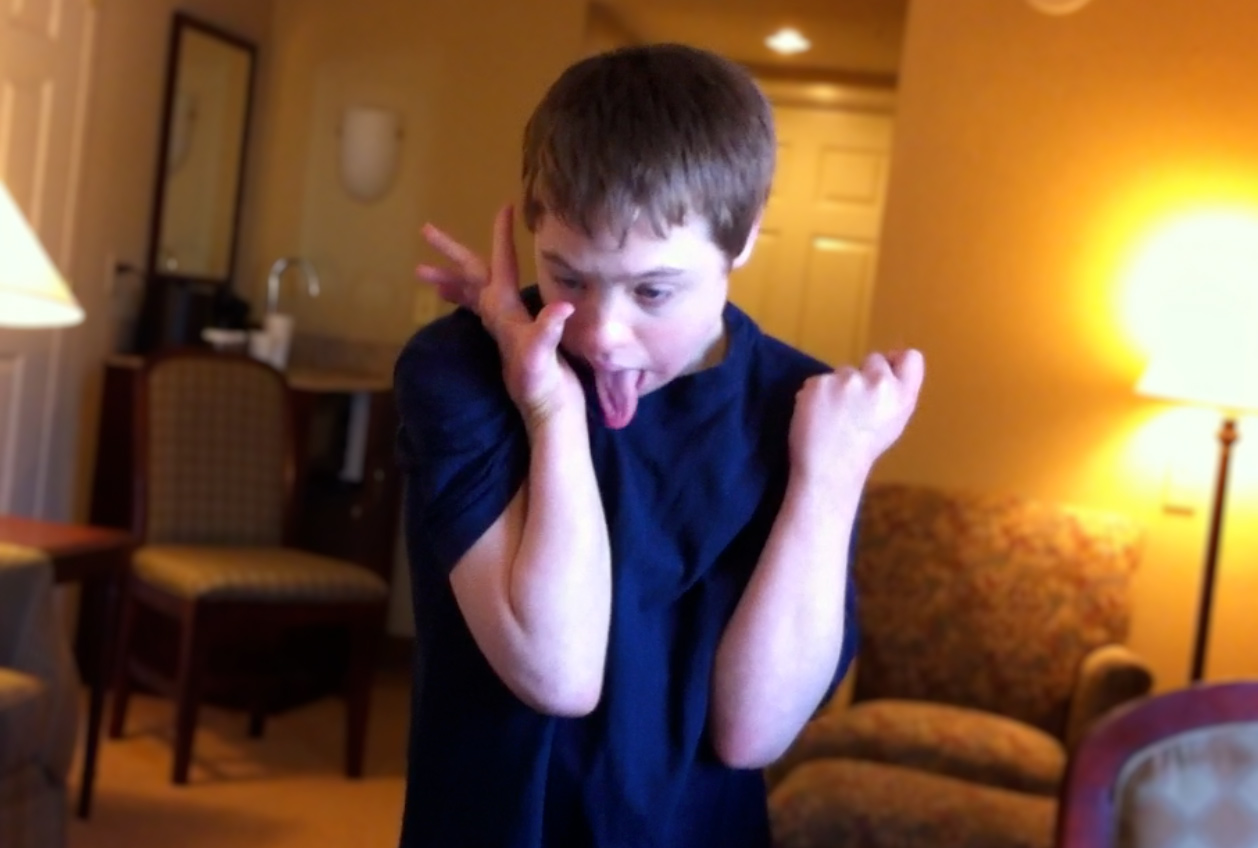Debilitating Sensory Addictions (DSAs): Stimming & Fidgeting
by Bob Doman
 Many parents and professionals are confused about unusual behaviors, generally referred to as “stims,” which are usually associated with autism. These “stims,” in fact, exist to varying degrees with many children and adults, some of whom have various developmental issues and some of whom are considered “typical.” During the past year, many parents of typical children have become concerned their child may fit into the autism spectrum, and a surprising number of normal adults are wondering if they fit into the spectrum as well. That being said, there are many children being permitted—and even encouraged—to engage in what are actually Debilitating Sensory Addictions (DSAs) which do need to be addressed. It’s important to understand what is, and is not, of concern.
Many parents and professionals are confused about unusual behaviors, generally referred to as “stims,” which are usually associated with autism. These “stims,” in fact, exist to varying degrees with many children and adults, some of whom have various developmental issues and some of whom are considered “typical.” During the past year, many parents of typical children have become concerned their child may fit into the autism spectrum, and a surprising number of normal adults are wondering if they fit into the spectrum as well. That being said, there are many children being permitted—and even encouraged—to engage in what are actually Debilitating Sensory Addictions (DSAs) which do need to be addressed. It’s important to understand what is, and is not, of concern.
Over ten years ago I coined the term DSA, or Debilitating Sensory Addictions, to identify most of what was being referred to as “stims” in children on the autism spectrum. These included developmentally harmful sensory behaviors which may occur in a broad range of children with developmental issues. I incorporated debilitating into the term to indicate that these behaviors are in fact debilitating, as in undermining and impairing development. In addition, these behaviors are addictive. The more the individual engages in the behavior, the stronger the addiction to the behavior becomes, and the more inclined they become to developing sensory and other addictions. The foundation of these behaviors is sensory dysfunction or delayed/underdeveloped sensory function.
Debilitating Sensory Addictions, although primarily seen in children on the autism spectrum, exist within the broad range of children with delayed development. This is particularly true for those with significant sensory issues. DSAs begin as a form of self-soothing or self-arousal behaviors. They originate around a “broken,” underdeveloped, or abnormal sensory channel and/or a lack of ability or opportunity to engage and interact appropriately with their environment, people, or toys. This was seen very graphically visiting state institutions for those with developmental issues back in the sixties and early seventies. The institutions were filled with “autistic” individuals who had entered after having been labeled or identified as having Down syndrome, cerebral palsy, or brain injuries, etc. The DSAs exhibited by these institutionalized children were often much more extreme than what we observe today in even the most severely involved autistic children. These children were, sadly, models of what can develop in permitted and untreated DSAs.
DSAs can involve any and all sensory channels and can incorporate more than one at a time. The most common DSAs involve vision and hearing. The most prevalent visual issues, in both children on the spectrum and others with developmental issues, is the delayed or slow development of central vision. Peripheral vision is the first vision that develops in all children. Peripheral vision picks up edges and movement. Most people know that babies are attracted to black and white images with sharp edges and to things that move.* These are things that they can see as opposed to things involving their central, or detail, vision. Most young children are far sighted, meaning they do not see things that are up close well. As they use this central vision more and more it generally improves. If, however, this development is delayed, the central vision may not improve. Delays to central vision development can occur when a child learns to play with their peripheral vision in such a way as to become aroused by this play. This can include waving their hands and objects in front of their eyes or lining up objects and flipping pages. It can also include, once they become mobile, moving around a room looking at the edges of the walls, ceiling, and floor, as well as other objects.
Often the first thing that is apparent with a child on the spectrum is the lack of eye contact. The reality is that it goes way beyond lack of eye contact, to not actually looking directly at many things, since they look peripherally. If you watch a typical person as they look around their environment, you will notice—unless they are thinking—that they look directly at faces or objects of significance. This is as opposed to a child or individual with hyper-peripheral vision and hypo-central vision who rarely look directly at anything and instead look rather absent, which they often are.
One of the common characteristics of those “on the spectrum” is the apparent inability to read expressions. I would propose that many, if not most, of those on the spectrum with this issue simply have underdeveloped central vision. They have learned to look at the periphery of the face (the hair that is sticking up or the edge of the ear), rather than the face itself. If you are not looking at the face, you are not seeing or reading the expression on the face.
DSAs related to hearing or auditory processing issues involve manipulating sound, from producing repetitive sounds with toys, to simply tapping or banging, to various forms of vocal repetitions of sounds, words, phrases, or songs. Also included is covering or batting at the ears to block or modify sounds.
As mentioned, all sensory channels can be involved in DSAs and can involve more than one sensory channel at a time. As an example, children can engage in hand/mouth DSAs that involve the senses of taste, touch, smell, and in some cases even hearing, all simultaneously. The DSAs involving many sensory channels are often the most difficult to resolve.
We can often equate the degree of DSAs and the degree to which individuals are or are not present with the global degree of developmental delay or the placement on the spectrum
One of the significant effects of DSAs is the child’s lack of connection to their environment or to being present. We incorrectly equate learning almost exclusively with being taught, but the reality is that most of what we learn—and what permits us to interact with our environment and the people in it—relates to the degree to which we are simply present. Those engaged in DSAs are to varying degrees not present.
Perseveration—stuck on repeat
A subtle form of DSAs involves perseveration. Perseveration involves wanting, needing, and essentially being addicted to specific input. Videos, commercials, books, and songs all have the potential of becoming perseverative addictions, or DSAs. If permitted, children will watch the same video over and over, or the same piece of a video over and over,** or want to hear the same book or song over and over. They do this to the point at which they have it memorized and beyond, because they are literally addicted to it. This type of DSA is of particular concern because the child can eventually watch the video, recite the line, or play the song in their head over and over; and although not displaying an overt DSA, they are simply not present. Many parents who are trying to get their child’s attention feel as though their child’s mind is someplace else. This is because their child’s mind is somewhere else; they are watching their video clip or repeating their sound bite in their mind. They are not present.
The greater the DSAs, the less present and connected are the individuals and the greater the impact on global development
The role of neuroplasticity is very relevant to DSAs. Essentially all development occurs because of neuroplasticity, which essentially means that the input the brain receives and how we use our brains determines how our brains become wired and develop. To trigger neuroplasticity, the more specific the input (stimulation) and the greater the frequency, intensity, and duration of the input (stimulation), the greater the impact on the brain and thus the more the brain is trained or developed in that direction. Typically, we perceive learning and stimulation as a good thing and work to utilize the components of neuroplasticity to maximize learning. If, however, we look at DSAs, they tend to occur with very repetitious specificity–high frequency, often with great intensity and extended duration—the model that changes the brain. Unfortunately, in the case of DSAs the change is all negative; it triggers neuroplasticity, but with harmful outcomes. If the DSA involves a “broken” undeveloped sensory channel, it tends to perpetuate and unfortunately strengthen what is “broken” and simultaneously wire the brain for more addictive behaviors. If the brain is focused on this intense input, it simultaneously diminishes the “normal” appropriate input that leads to “normal” development.
Sensory/developmental imbalance and sequential processing
In typical development, changes across the sensory and functional areas are balanced. DSAs and sensory issues tend not to be balanced, meaning unequal. As such, the overall development is imbalanced. A very significant related factor is found in auditory and visual sequential processing. This refers to the number of sequential pieces we can hear or see. This is typically measured in digit spans. If I said a number sequence to you at one second intervals, such as 5-2- 7- 3- 9-0-8 and if you could repeat it, that would give you an auditory digit span of seven, which is normal for most adults. This would be a measure of your auditory processing, or short-term memory, which equates with how much you process of what is said to you. Hearing a list of numbers and repeating them backwards, a reverse auditory digit span, would be a measure of your working memory, which is now being referred to as the new IQ and is the foundation of executive function. Executive function is what permits us to have self -control, inhibit inappropriate behaviors, plan, organize, set goals, problem solve, prioritize–all functions that are challenging for many on the spectrum. Typically, auditory sequential processing develops at about ¾ of a digit a year from birth to about 9 years of age. For most children this growth of processing—including short term and working memory—expands simply by people talking to the child and the child being present and listening. If the child is not present, it significantly impairs this development with global impact, affecting all aspects of typical development, most notably the ability to understand language, to think in words, to develop language, and to think conceptually.
Essentially, we think in either words or pictures. Thinking in words is called conceptualization and thinking in pictures is called visualization. Because of not being present and other issues, many children with DSAs do not develop auditory processing well and lag behind, often dramatically, in learning to think well in words. Simultaneously, the ability to think in pictures, to visualize, keeps getting stronger, creating a greater and greater imbalance. This is often the root cause of the lack of language development and maturity in children on the spectrum. Often behavior outbursts occur because what is happening in real time does not fit the picture in the child’s mind, and their inability to think in words inhibits their ability to think their way through the situation.
Stim is short for stimulation—a misnomer
We generally perceive stimulation as a good thing, and perhaps, therefore, many tend to think of stims as being good and to be permitted, if not encouraged. But, as stated previously, stims/DSAs are providing the brain with negative input which is detrimental to development. DSAs deprive the individual the means to engage and interact with their environment and produce “bad” brain wiring. My grandfather liked to use the saying “Call an ace an ace.” If we are going to address and fix debilitating sensory additions, let’s start by calling them what they are: DSAs.
Attention, inattention, distraction, and fidgeting—good, bad or ???
What is fidgeting? I correlate fidgeting with the issue of DSA’s obstructing the individual’s ability to be present. If a child or adult is actively engaged in behaviors to varying degrees that prevent them from being present, then I would classify the behavior as a DSA. There is a disturbing tendency to see many (and tragically in some cases, most) children as needing more sensory input. Quite to the contrary. The reality is the need to teach the child, and their brain, to focus, to filter, and to ignore extraneous, disruptive input. To believe that many children in a classroom need additional sensory stimulation is ludicrous. Twenty plus children are in a classroom, with all of them breathing, moving, squirming, mumbling, and talking, while other children move down the hallways, trucks go past outside, and planes flying overhead. All the while, they are supposed to be attending to their teacher or their work. The problem is not children being deprived of sensory input; it’s children being overloaded by sensory input and learning how to tune it out, not tune into it. The more distractions, the tougher it is for the child to learn how to filter and attend. When you were going to school, would you have had a better time attending to your work in a library or in the gym during a basketball game? The few who need a thing to occupy part of their brain while they are learning to filter and focus does not justify teaching others to be distracted and dependent and even addicted to inappropriate actions or mechanisms.
For a small percentage of children and adults, the intention and function of a behavior, such as tapping a foot or a finger to help maintain focus, could be considered a short term needed mechanism, although identifying and addressing the underlying issue or issues is to be preferred. The need for fidgeting may exist because of some residual sensory deficit, such as hyper-peripheral visual distractions or residual figure ground issues; but if the result is better attention and the individual being more present, then, while not to be encouraged, it is fine. Fidgets can also be the reflection of being “wired” from a poor or individually inappropriate diet, from present anxiety or nervousness, or from a residual behavior resulting from previous anxiety. Sometimes it might not even have any direct sensory association at all. But encouraging otherwise typically developing children to adopt such behaviors is counter to healthy normal development.
It is vital to look at all these actions and behaviors that have been lumped together as stims from the perspective of the individual. Most of these behaviors have underlying sensory issues which need to be identified and developed. If understood as addictions, it becomes obvious that we need to do all that we can in order to reduce and eliminate them as much as possible. This process typically involves redirection, elimination of any tools that facilitate DSAs, and appropriate engagement for as much of the waking day as possible. If one of the net results of DSAs is prevention of the individual from being present and engaged, then we need to do everything we can to keep them present and engaged. Sensory channels that are underdeveloped, or which have developed improperly, need to be treated. If sequential processing, short-term memory, working memory, and executive function work together to be the foundation which permits us to learn, develop, to think, and function in society, we need to actively and specifically work to develop these incredibly important functions.
Every person is unique. One of the things I taught both of my sons when they were young and perceptive enough to be able to observe the differences between and oddities of their friends and classmates, was that if you met someone and you did not think they were “weird,” it only meant you didn’t know them well enough. We are all “weird” if you look closely enough, which is rather synonymous with different and unique. That is a good thing and bodes well for the perpetuation of our species. Often labels and terms can cause more harm than good. When we can be definitive, we need to be. When we can identify issues as specific to the individual, we need to. Lumping children together with similar symptoms, and often perceiving these symptoms as pervasive, tends to imply that these symptoms are just part of who and what they are and thus to accept it. Having worked with thousands of individuals with DSAs over fifty years, the most important lesson learned is that each child is unique and complex—and needs to be perceived as such. Doing so is the first important step in helping them do and be what their innate potential would permit them to be. Understanding these associated pieces which are distinctive to the individual leads to creating the necessary tools and the ability to treat each child appropriately so that we can unlock their innate potential.
The children have unlimited potential. Our lack of knowledge and the application of that knowledge is the causative factor which limits the outcomes.
*Some children on the spectrum demonstrate an exceptional ability to identify numbers, letters, and words and even to be able to read at an early age, which appears to be the result
of an early attraction to the edges of numbers and letters.
** YouTube has made some children on the spectrum tablet navigation experts, as they are driven to pursue their addictions to specific videos.
Reprinted by permission of The NACD Foundation, Volume 36 No.1, 2023 ©NACD





